HR professionals become more and more metrics-driven. Businesses aim to attract high performing talents to beat the competitors and generate more revenue, while HR managers look for ways to maximize the effectiveness of their strategies. To measure it, they refer to HR metrics that help identify strengths and vulnerabilities of HR strategies in companies.
In this article, we cover the following types of HR metrics:
- HR metrics on Absenteeism
- HR metrics on Engagement
- HR metrics on Recruitment
- HR metrics on Employee Performance
- HR metrics on Training & Development
- HR metrics on Employee Benefits
What Are HR Metrics?
Human capital is the driving force and the competitive advantage of every organization, so it’s vital to track their performance. Human resources (HR) metrics are used to measure the effectiveness of HR processes and employee programs. HR metrics range from evaluating each employee to predicting strengths and vulnerabilities of the current HR strategy.

Importance of HR Metrics
HR metrics bring the most benefits to HR managers in the following ways:
- They improve employee hiring, scheduling and compensation;
- Help develop better PTO and benefits policies;
- Decrease compliance risks, including FMLA, PBJ and ACA compliance;
- Improve the ROI of HR programs (engagement, wellness, financial planning, performance).
At the same time, employers can use HR metrics to review workforce data, see employee performance in the context of the whole business strategy, identify vulnerabilities that require improvement and when introduced, measure their effectiveness.
Most Important HR Metrics
There are dozens of various HR metrics and tracking all of them is a tremendous waste of time. Instead, pick the ones that your business and current HR strategy requires. To help you choose the most important ones in your particular case, we’ve grouped them into categories and supplied quantitative metrics with their respective formulas.
Key HR Metrics on Absenteeism
Absenteeism is frequent employee absence from their work. Usually, these are unplanned absences that don’t include authorized leaves and paid time off. Let’s see what HR metrics help measure absences and prevent absenteeism.
1. Absenteeism rate
Absence or absenteeism rate is the rate of unplanned absence due to sickness or other causes, that usually include mental health issues, workplace bullying, family issues and others. While monthly absenteeism rates may differ, long-term rates equal to about 1-2% are considered normal. Growing absenteeism rates usually indicate increased stress or a flu epidemic.
Metric formulas:
Individual absenteeism rate = (number of absent days / number of workdays in a given period) X 100%
Team absenteeism rate = number of absent days / (average number of employees X number of workdays) X 100%
Pro tip:
To track employee absences and leave balances, consider absence management software like actiPLANS. Get your team to register their leaves, tardiness, work-from-home and other leaves and statuses in a single team calendar starting at $1.5 per user per month. Try actiPLANS for free with a free 30-day trial.
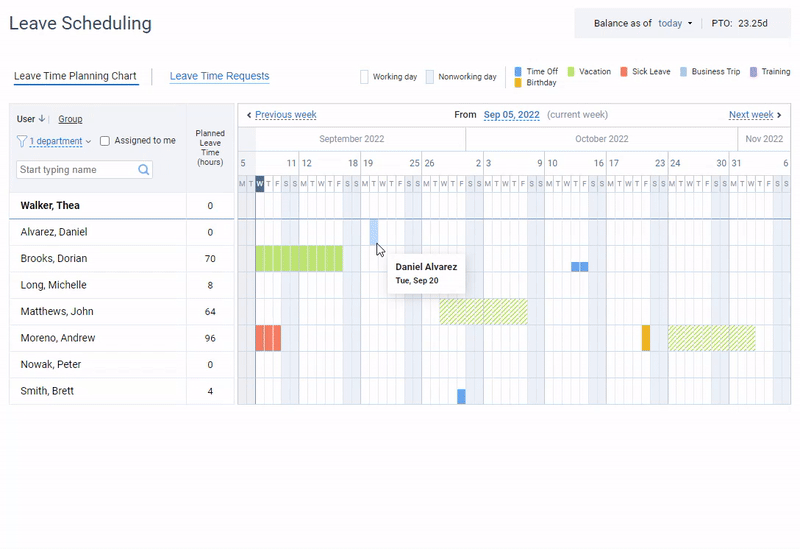
Leave management in actiPLANS – create an unlimited number of leave types, get your team to request and plan their time off and review employee availability
2. Overtime expense
Excessive overtime is one of the reasons for absenteeism. After your team works overtime for a few days or even weeks in a row, they are very likely to take unplanned absences or even leave the company. If overtime levels are consistently high, consider hiring more employees.
Pro tip:
To keep track of working time and overtime, automate PTO calculations, manage time across tasks, projects and clients, consider time tracking software like actiTIME. Introduce online weekly timesheets with a free mobile app starting at $5 per user per month.
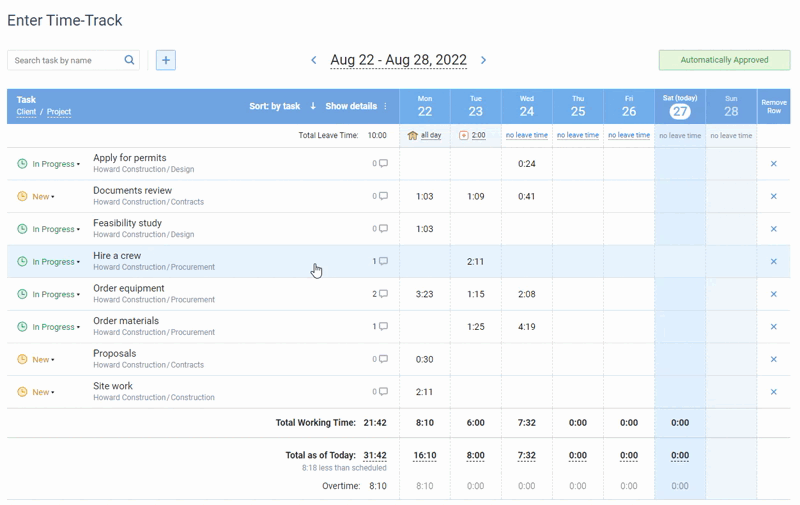
actiTIME timesheet where you can register working hours, change task status and order and review estimates and deadlines
3. Used vacation days
Poor work-life balance is one of the most common reasons for employee absenteeism. Luckily, HR managers can use absence management systems to see how many vacation days have been offered to an employee and how many of them they have used during a year or half a year. This way, HR managers can determine if employees have a healthy work-life balance and if not, help them achieve it.
Metric formula:
Percentage of vacation days used = (number of vacation days used / number of vacation days offered) X 100%
Key HR Metrics on Engagement & Retention
4. Employee satisfaction
Employee satisfaction is an important factor in employee motivation, employee goal achievement, cost savings, customer satisfaction, positive employee morale, and more in the workplace. To improve work environment quality, employee retention and productivity rates consider measuring this HR metric regularly.
Metric formula:
Ask an employee to answer the following questions on a scale from 0 to 10:
1. How satisfied are you with your current workplace?
2. How well does your current workplace meet your expectations?
3. How close is your current workplace to the ideal one?
Add these three figures and insert them into the following formula:
Employee satisfaction = ((score sum / 3) – 1) / 9 X 100%
5. Total turnover rate
Employee turnover rate is the percentage of employees who leave an organization, including voluntary resignations, dismissals, non certifications and retirements. To understand if turnover rate in your company is high or low, compare it with the average rate within your industry or consult the following diagram that displays average turnover rates across industries in the US.
Metric formula:
Employee turnover rate = (number of departures during a specific time period / average number of employees during the same time period) x 100%
6. Retention rate
Retention rate is the percentage of employees who remained on staff from the beginning to the end of a time period. The average retention rate in the US is around 90% but varies across industries.
The biggest misconception about employee retention rate is that it’s the opposite of the turnover rate. So, let’s say employee turnover rate in a company is equal to 15.7%, which means that retention rate is 84.3% - that’s not always true. So, calculate these two metrics separately.
Metric formula:
Employee retention rate = (number of employees who remained employed for entire measurement period / number of employees at start of measurement period) x 100%
Key HR Metrics on Recruitment
7. Cost per hire
Cost-per-hire (CPH) is the average cost of hiring a new employee, which includes recruitment expenses, relocation expenses, administrative costs, benefits and equipment.
Metric formula:
Cost per hire = total cost of hiring / number of new hires
8. Time to hire
Time to hire (or time to fill) is the average number of days it takes to hire a candidate for a role. The starting date is usually when the job position is approved, and the ending date is usually the first day an employee starts the job. But you can modify the formula and, for example, use the day the candidate accepted the offer instead of the day of their first day at work.
Metric formula:
Time to hire = the day candidate starts the job - the day the job position is approved
9. Quality of hire
Quality of hire (QoH) measures the value that new hires bring to a company. This metric is especially important for small and middle-sized businesses where success of the company is heavily defined by the quality of staff.
Metric formula:
Quality of hire = (Job performance score + Ramp-up time score + engagement score + cultural fit score) / number of indicators
Pro tip:
Measure quality of hire once in a year to track the health of your employee base and improve the recruiting process.

Key HR Metrics on Employee Performance
10. Revenue per employee
Revenue per employee roughly measures how much money each employee brings to the company. This HR metric is important when reviewing the historical changes or comparing it against that of other companies.
Metric formula:
Revenue per employee = annual revenue / current number of employees
11. Performance & potential
A nine-box grid is a matrix tool that allows managers to categorize employees according to their performance and potential levels. Nine-box grids are widely used during the talent review process when managers identify employees with high potential and those who need training.
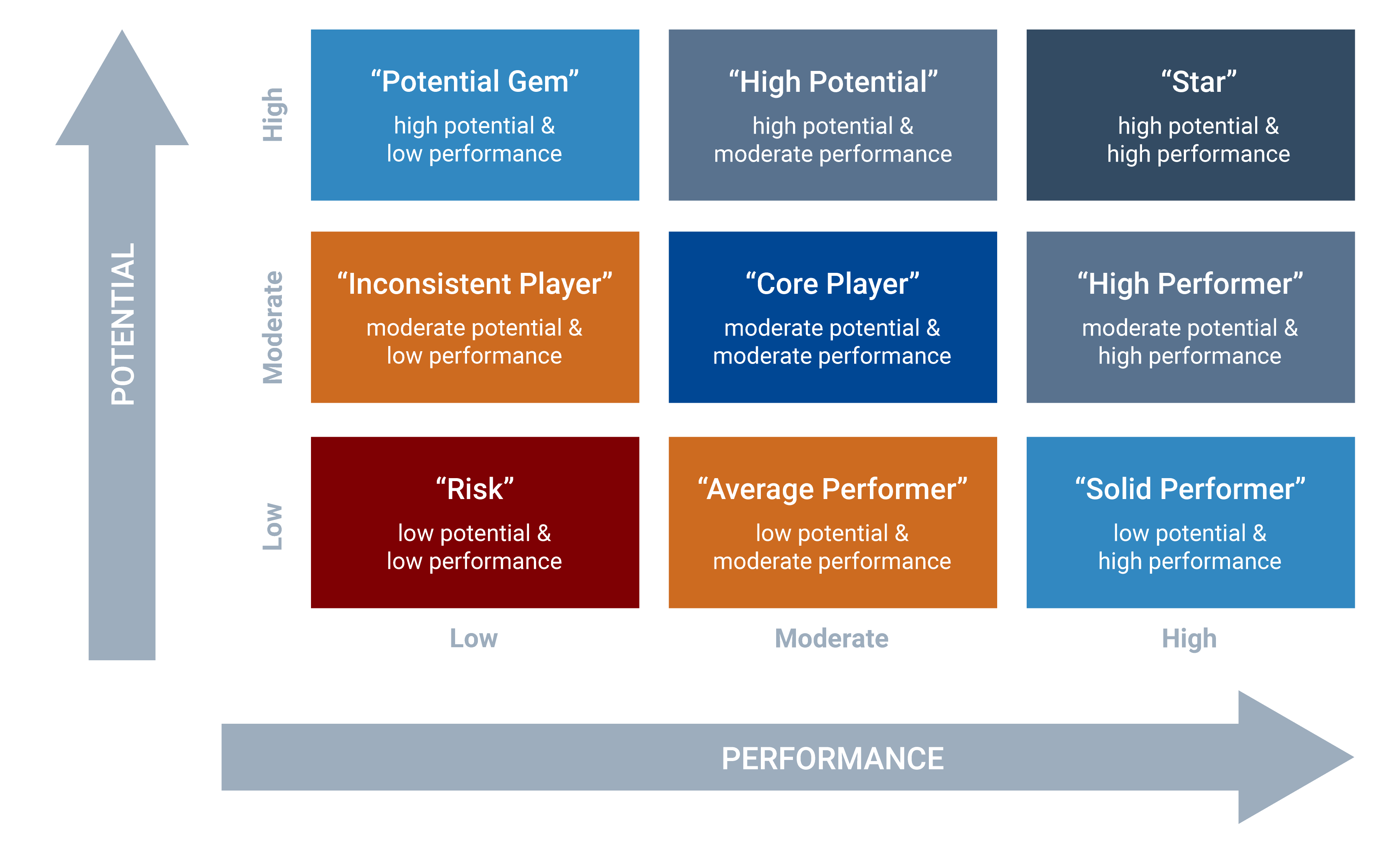
Pro tip:
Managers’ perspectives can be subjective. So, to sort employees accurately, it’s important to be as objective as possible. Consider time tracking software to measure employee performance based on their time and output and make more objective decisions.
12. Goal tracking
Encourage project managers to set individual goals that connect to larger organizational goals. These goals may have different time frames - from a few months to a year. Track these goals to see how employees are performing and adding value to the company.
Key HR Metrics on Training & Development
13. Training cost per employee
Training cost per employee is an HR metric that shows the total cost of your organization’s training courses and programs, not to mention the hidden costs like paperwork and manager’s attention.
Metric formula:
Training cost per employee = total training costs / number of employees
14. Training hours per employee
Training hours per employee is another HR metric that displays the average number of hours required to train an employee. It’s important to track these hours, because during the training period, employees don’t generate value to the company, so along with training effectiveness metric it helps managers to understand if these training programs are effective.
Metric formula:
Training hours per employee = total training hours / number of employees
Pro tip:
To track training time, consider absence tracking software. Ask employees to use a special leave status with a number of training hours to display it in the team calendar and in absence reports.
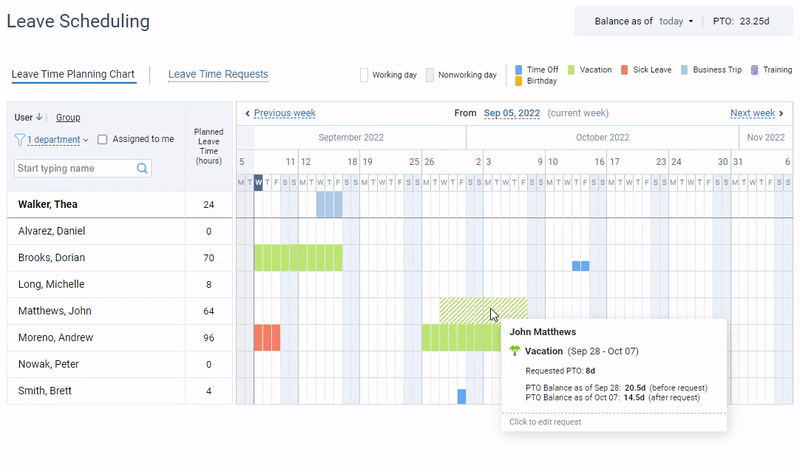
Leave management in actiPLANS - approve, modify or reject leave requests and leave comments
Key HR Metrics on Employee Benefits
15. Leave time and costs
Leave time is an important metric for identifying absenteeism and sick leave abuse, calculating wages and associated leave costs.
Pro tip:
Introduce time tracker or leave tracking software in your company to keep track of employee leave time and streamline absence management routines. Get your employees to track their absences and review associated metrics using charts and reports.
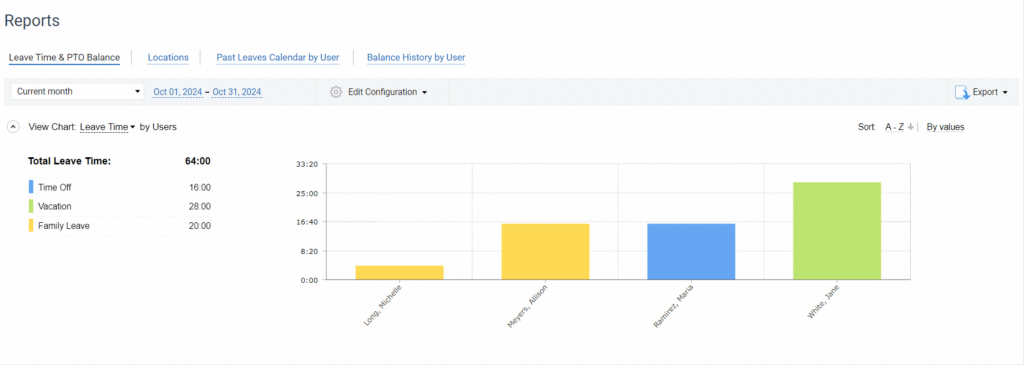
Ready to Upgrade HR Routines in Your Company?
There are more than 15 HR metrics and tracking all of them is not necessary. The good news is that most of them are time-based, so software that records work and leave time does half of the job for you.
So consider actiPLANS - leave management software where you can manage leave requests, create corporate schedules, automate leave balance calculations and review absence metrics using charts and reports. If you connect it with actiTIME time tracking software, you’ll get a business management environment where you can review employee performance, absences, work and leave time and more. Try actiPLANS for free with a 30-day trial to explore all the benefits.




